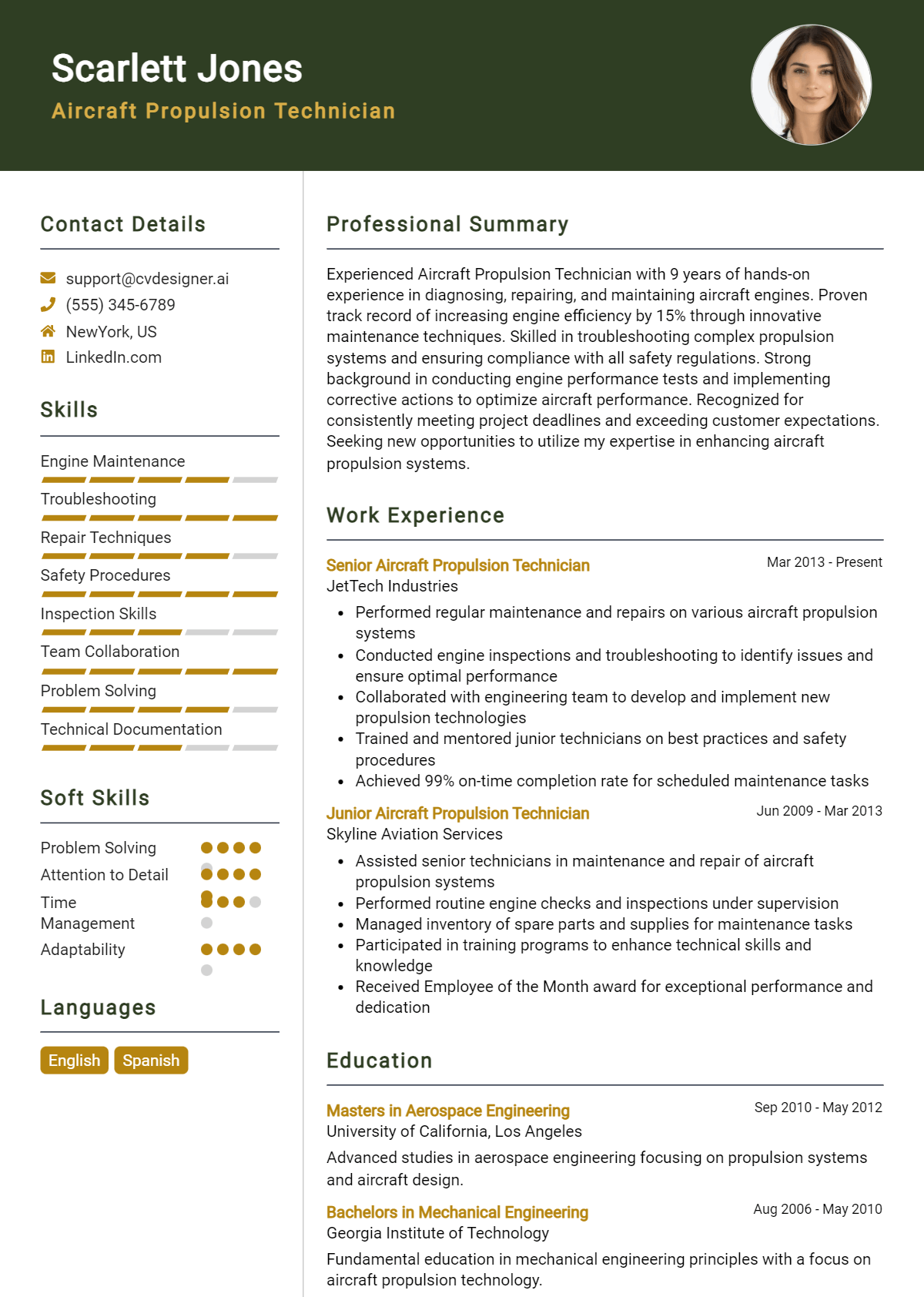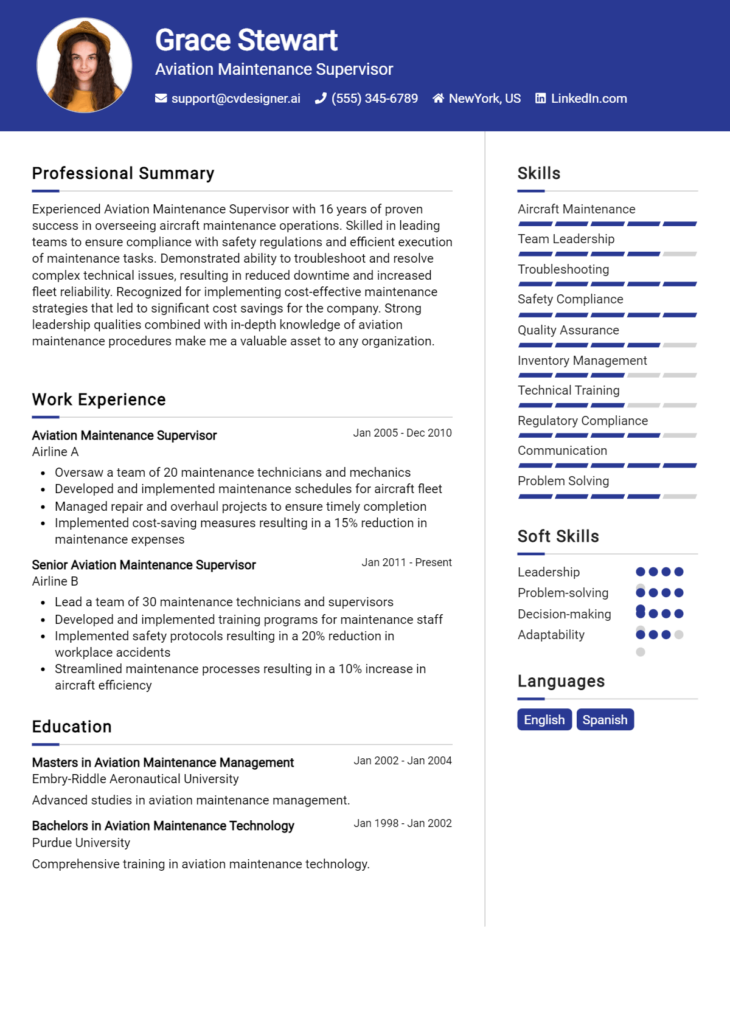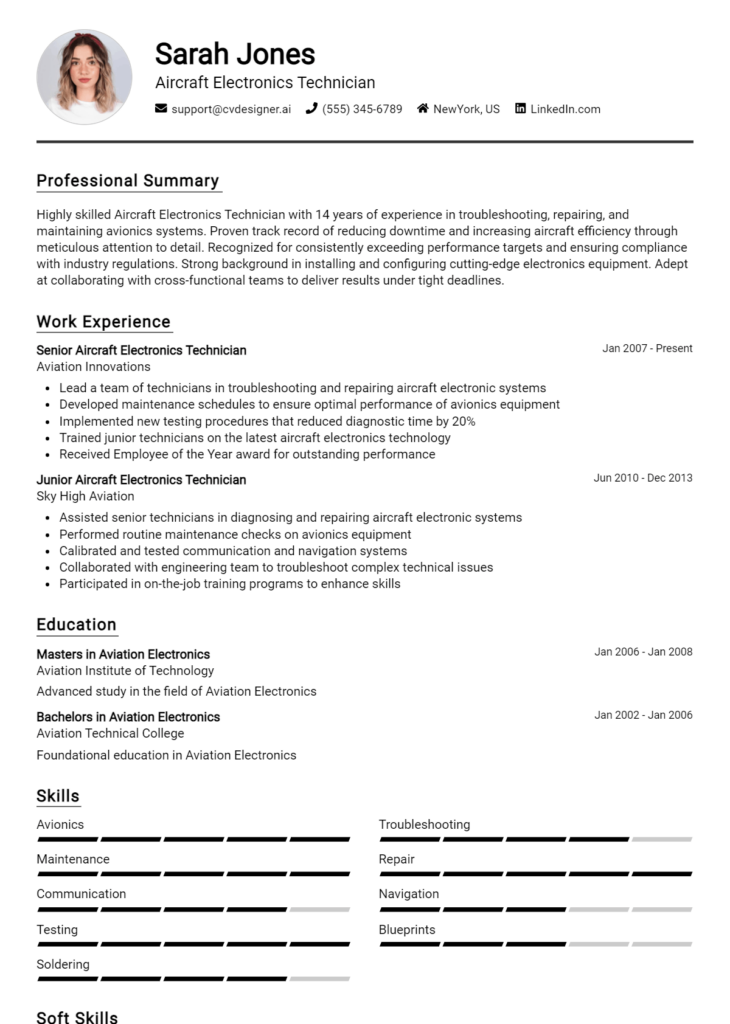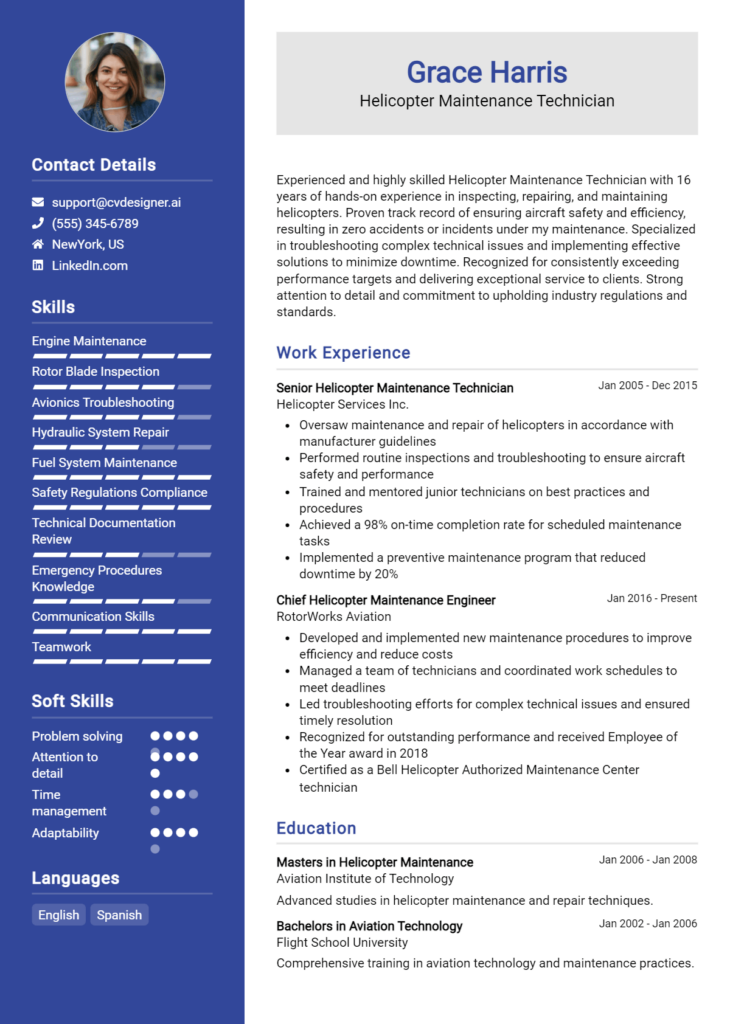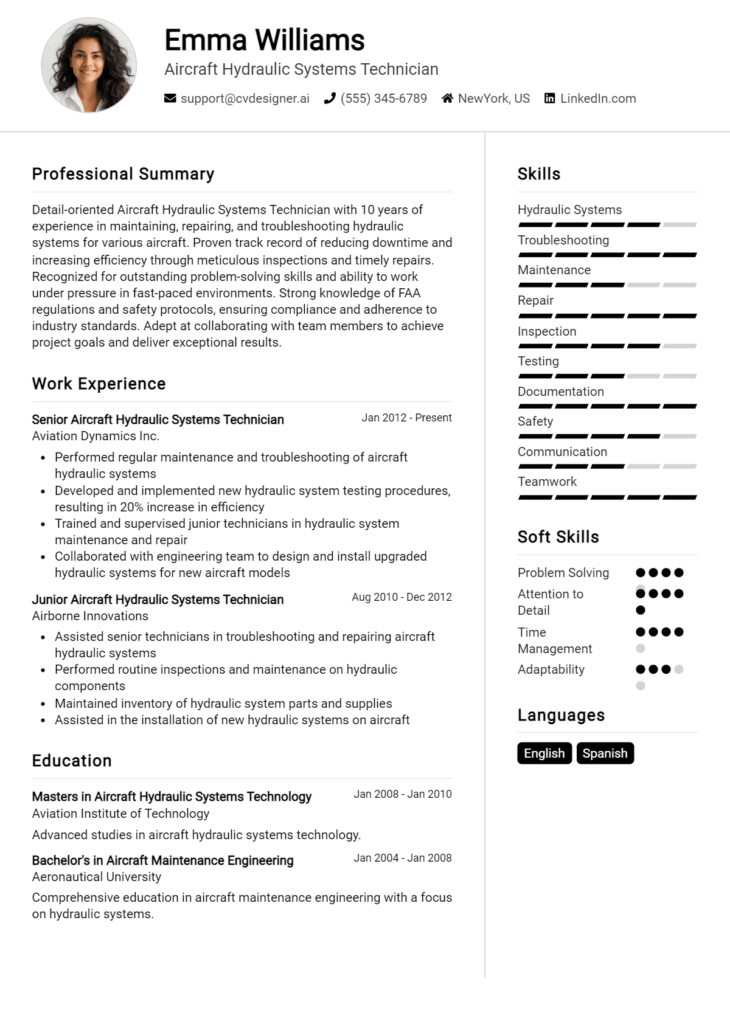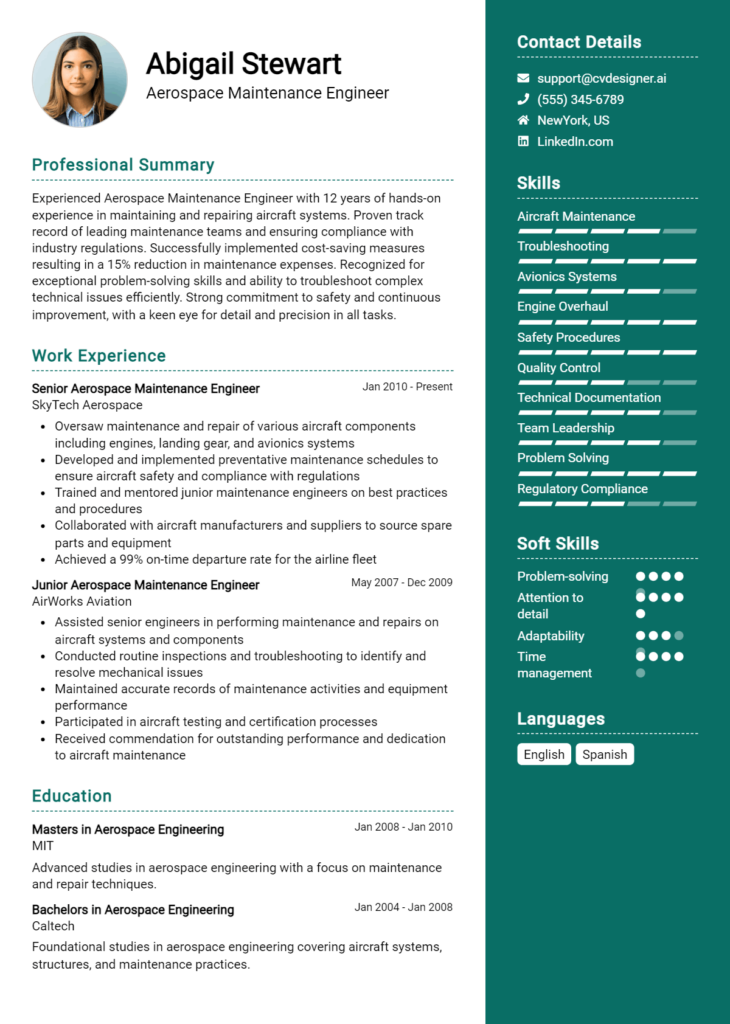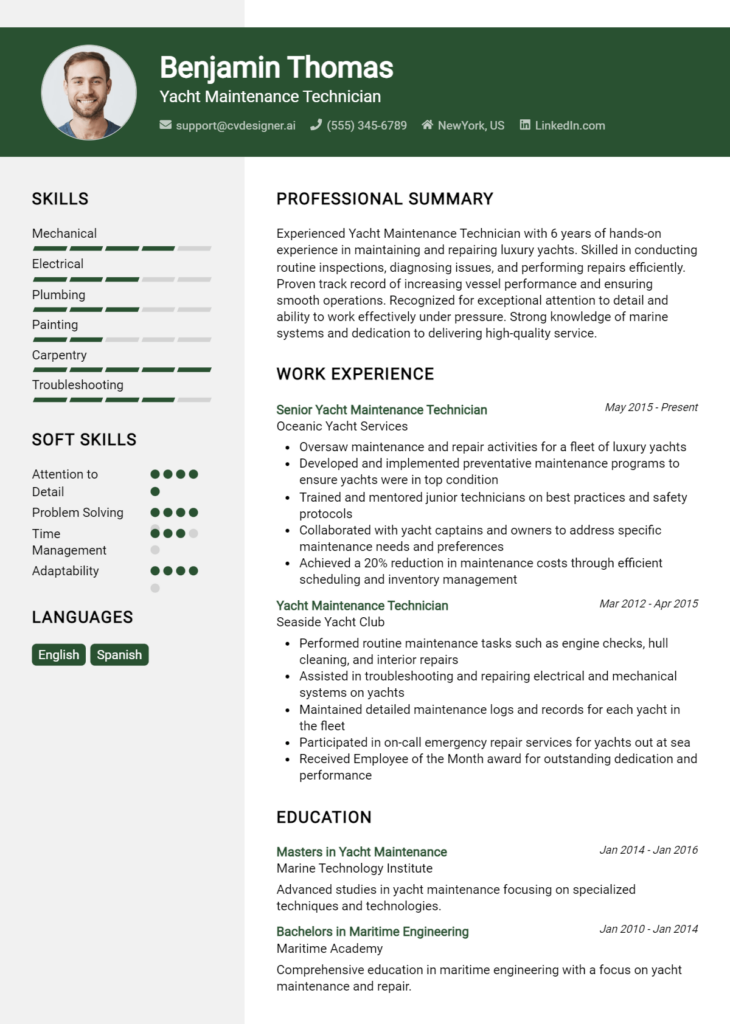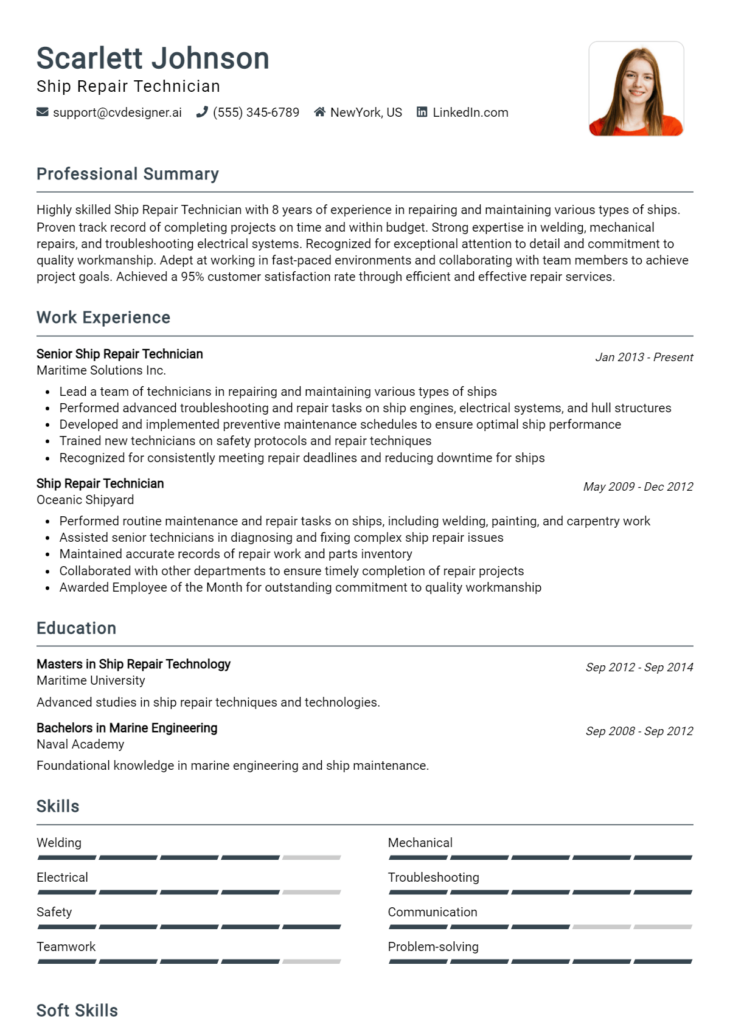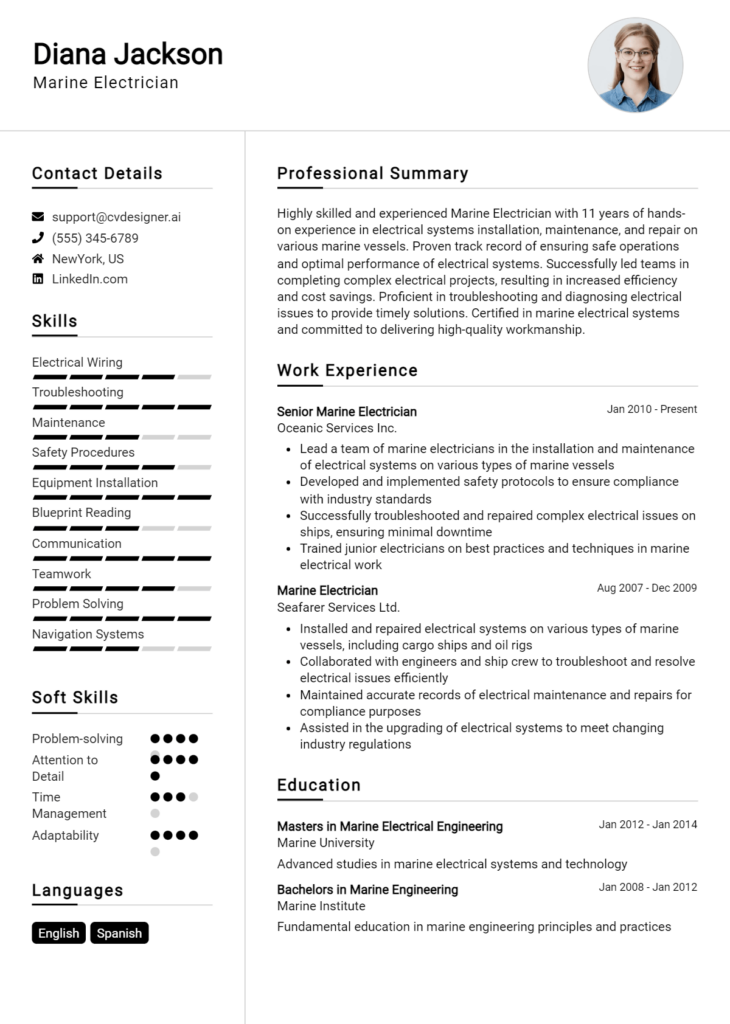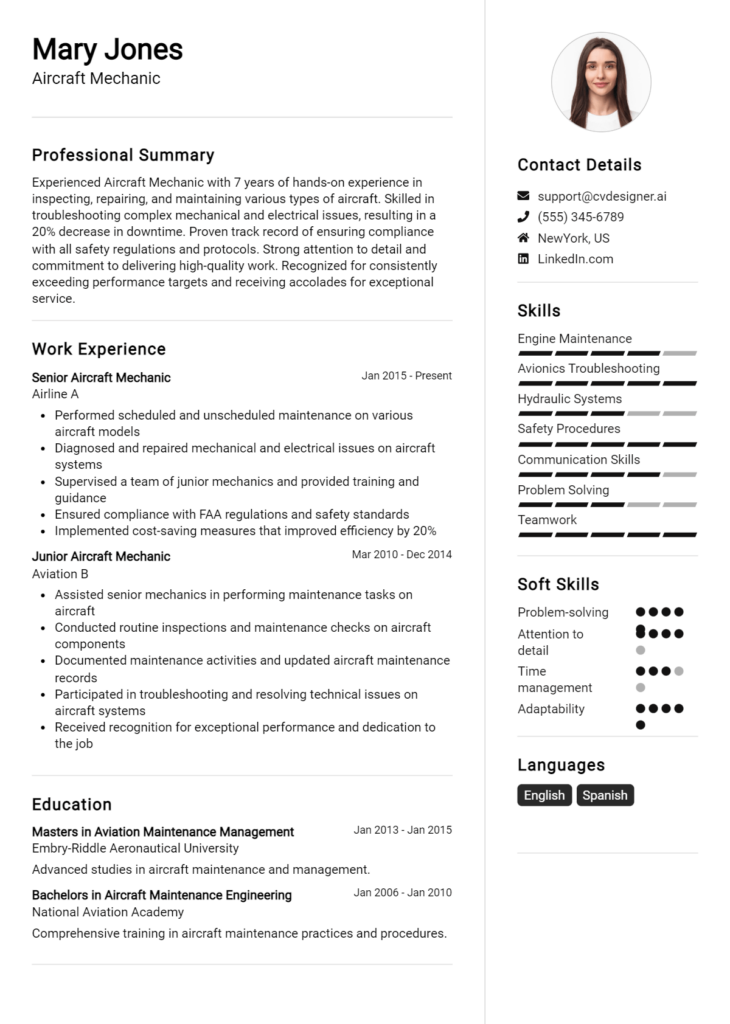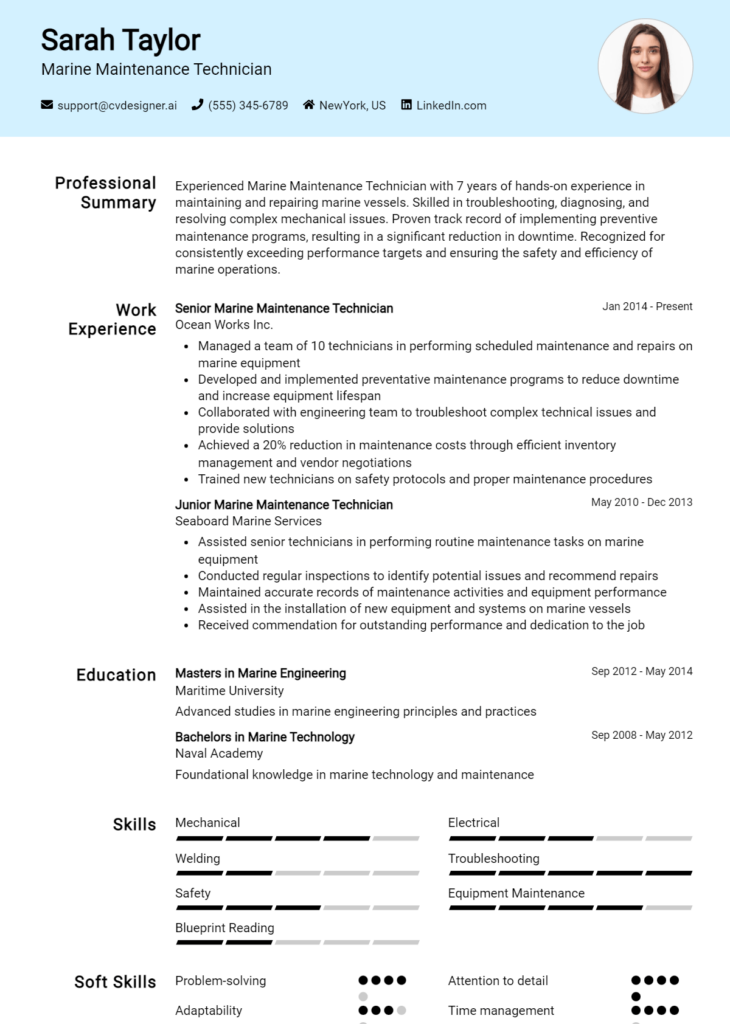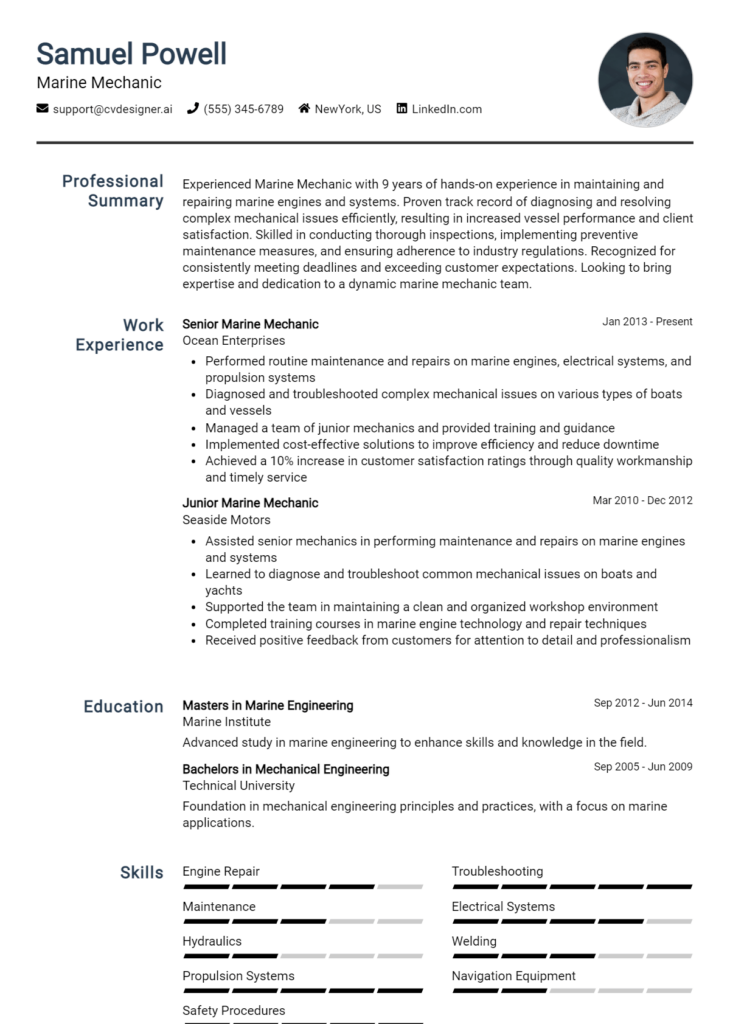Aircraft Propulsion Technician Core Responsibilities
An Aircraft Propulsion Technician plays a crucial role in ensuring the safe and efficient operation of aircraft engines. Key responsibilities include diagnosing and repairing propulsion systems, conducting routine maintenance, and collaborating across departments such as engineering and quality assurance. Success in this role requires strong technical skills, operational knowledge, and exceptional problem-solving abilities. These competencies contribute significantly to the organization's safety and performance goals, making a well-structured resume essential to showcase these qualifications effectively.
Common Responsibilities Listed on Aircraft Propulsion Technician Resume
- Conducting routine inspections and maintenance on aircraft propulsion systems.
- Diagnosing and troubleshooting engine malfunctions and performance issues.
- Performing engine overhauls and component replacements.
- Collaborating with engineering teams to implement design modifications.
- Documenting maintenance activities and compliance with safety regulations.
- Utilizing diagnostic tools and software to assess engine performance.
- Training junior technicians on best practices and safety protocols.
- Ensuring adherence to manufacturer specifications and industry standards.
- Participating in safety audits and quality control inspections.
- Assisting in the development of maintenance procedures and manuals.
- Maintaining inventory of parts and tools necessary for repairs.
- Providing technical support and expertise to other departments as needed.
High-Level Resume Tips for Aircraft Propulsion Technician Professionals
In the competitive field of aircraft propulsion technology, a well-crafted resume is not just a formality; it is a crucial tool that can significantly influence your career trajectory. For professionals in this specialized area, the resume serves as the first impression you make on potential employers, showcasing not only your technical skills but also your notable achievements and experiences. A strong resume should effectively communicate your qualifications, demonstrating how you can contribute to the success of an organization. This guide will provide practical and actionable resume tips specifically tailored for Aircraft Propulsion Technician professionals, helping you create a document that stands out in a crowded job market.
Top Resume Tips for Aircraft Propulsion Technician Professionals
- Tailor your resume to the specific job description, using relevant keywords that match the skills and qualifications listed in the posting.
- Highlight your relevant experience in aircraft propulsion systems, including your hands-on work with engines and related components.
- Quantify your achievements by including specific metrics, such as improvements in efficiency, reduction of downtime, or successful project completions.
- Showcase industry-specific skills, such as knowledge of turbine engines, propulsion system testing, and maintenance protocols.
- Include relevant certifications and training that demonstrate your qualifications and commitment to professional development.
- Use action verbs to describe your responsibilities and accomplishments, making your contributions clear and impactful.
- Keep your resume concise and focused, ideally one page, while ensuring it remains easy to read with bullet points and clear headings.
- Incorporate any experience with advanced technologies or software used in the propulsion field, such as engine diagnostic tools.
- Highlight your ability to work collaboratively in a team environment, emphasizing communication skills and teamwork in complex projects.
By implementing these tips, you can significantly increase your chances of landing a job as an Aircraft Propulsion Technician. A resume that effectively showcases your skills, achievements, and relevant experience will not only capture the attention of hiring managers but also position you as a strong candidate in this demanding field. Take the time to refine your resume, and you'll be one step closer to achieving your career goals.
Why Resume Headlines & Titles are Important for Aircraft Propulsion Technician
In the competitive field of aircraft propulsion technology, crafting a compelling resume is essential for standing out to potential employers. Resume headlines and titles play a crucial role in this process, as they serve as the first impression a hiring manager will have of a candidate. A strong headline can immediately capture attention and succinctly summarize a candidate's key qualifications in a single, impactful phrase. This element should be concise, relevant, and directly related to the job being applied for, effectively setting the tone for the rest of the resume and highlighting the candidate's expertise in aircraft propulsion systems.
Best Practices for Crafting Resume Headlines for Aircraft Propulsion Technician
- Keep it concise: Aim for a headline that is no longer than a single sentence.
- Be role-specific: Tailor the headline to reflect the specific job title and responsibilities.
- Highlight key skills: Incorporate relevant technical skills or certifications that distinguish you.
- Use action-oriented language: Start with strong verbs or adjectives that convey competence and confidence.
- Include years of experience: If applicable, mention your years of experience in the field to add credibility.
- Avoid jargon: Use clear language that is easily understood by hiring managers who may not be technical experts.
- Make it relevant: Ensure that the headline aligns with the job description and company values.
- Showcase accomplishments: If possible, include a notable achievement that demonstrates your impact in previous roles.
Example Resume Headlines for Aircraft Propulsion Technician
Strong Resume Headlines
Certified Aircraft Propulsion Technician with 5 Years of Experience in Jet Engine Maintenance
Detail-Oriented Aircraft Propulsion Specialist Skilled in Advanced Propulsion Systems and Troubleshooting
Dynamic Aircraft Technologist with Proven Expertise in Fuel Efficiency Enhancements and Engine Overhauls
Weak Resume Headlines
Technician Seeking Job
Experienced Worker in Aviation
The strong headlines are effective because they are specific, clearly articulating the candidate's qualifications and experience relevant to the aircraft propulsion technician role. They highlight key skills and certifications while also demonstrating the candidate’s value with concrete examples. In contrast, the weak headlines lack specificity and fail to convey the candidate's expertise or unique strengths, making them easily forgettable. By not addressing the specific role or showcasing relevant qualifications, weak headlines miss the opportunity to engage hiring managers and make a strong first impression.
Writing an Exceptional Aircraft Propulsion Technician Resume Summary
Crafting an exceptional resume summary is crucial for an Aircraft Propulsion Technician as it serves as the first impression to hiring managers. A strong summary quickly captures attention by succinctly showcasing key skills, relevant experience, and notable accomplishments related to the job role. In a competitive field, this brief introduction must be concise, impactful, and tailored to the specific position the candidate is applying for, ensuring that it stands out in a sea of applicants.
Best Practices for Writing a Aircraft Propulsion Technician Resume Summary
- Quantify achievements: Use numbers to demonstrate the impact of your work, such as improvements in efficiency or reductions in downtime.
- Focus on relevant skills: Highlight technical skills and certifications that are directly related to aircraft propulsion systems.
- Tailor for the job description: Customize your summary to reflect the specific requirements and keywords mentioned in the job posting.
- Keep it concise: Aim for 2-4 sentences that deliver the essence of your qualifications without excess detail.
- Use action verbs: Start sentences with strong action verbs to convey proactivity and competence.
- Highlight industry experience: Mention years of experience and specific roles that align with the requirements of the position.
- Showcase problem-solving abilities: Include examples of how you have successfully addressed challenges in your past roles.
- Incorporate soft skills: Briefly mention interpersonal skills, such as teamwork or communication, that are essential in a technical environment.
Example Aircraft Propulsion Technician Resume Summaries
Strong Resume Summaries
Detail-oriented Aircraft Propulsion Technician with over 8 years of experience in maintaining and troubleshooting jet propulsion systems. Achieved a 20% reduction in engine downtime through proactive maintenance schedules, enhancing operational efficiency in a high-stakes environment.
Proficient Aircraft Propulsion Technician skilled in both turbine and reciprocating engines, possessing a FAA Airframe and Powerplant certification. Successfully led a team to overhaul an aircraft engine, resulting in a 15% increase in performance metrics and improved fuel efficiency.
Results-driven Aircraft Propulsion Technician with a strong background in diagnostics and repairs of propulsion systems. Instrumental in implementing a new testing protocol that reduced error rates by 30%, significantly improving safety standards and compliance.
Weak Resume Summaries
Experienced technician with some background in aircraft engines and maintenance. Good at problem-solving and working with others.
Aircraft Propulsion Technician seeking new opportunities and looking to utilize skills in a challenging environment. Knowledgeable in engines and maintenance practices.
The strong resume summaries are considered effective because they include specific achievements, quantifiable results, and relevant skills that directly correlate with the job role. In contrast, the weak summaries are vague and generic, lacking detailed accomplishments or clarity regarding the candidate's qualifications, making it difficult for hiring managers to see their potential value to the organization.
Work Experience Section for Aircraft Propulsion Technician Resume
The work experience section of an Aircraft Propulsion Technician resume is crucial as it serves as a comprehensive showcase of the candidate's technical skills, hands-on experience, and teamwork capabilities. This section allows potential employers to assess not only the applicant’s proficiency in aircraft propulsion systems but also their ability to lead teams and deliver high-quality results under pressure. By quantifying achievements and aligning experiences with industry standards, candidates can effectively demonstrate their value and readiness for the role, which is essential in this competitive field.
Best Practices for Aircraft Propulsion Technician Work Experience
- Use specific technical terminology relevant to aircraft propulsion systems.
- Quantify achievements with metrics, such as reduced downtime or increased efficiency percentages.
- Highlight leadership roles in team projects to demonstrate management capabilities.
- Detail responsibilities and accomplishments in each position to provide a clear picture of your skill set.
- Align experiences with the job description to show direct relevance to the role.
- Include training and certifications that enhance your technical expertise.
- Showcase collaborative efforts on projects to illustrate teamwork and communication skills.
- Use action verbs to convey a sense of proactivity and impact in your roles.
Example Work Experiences for Aircraft Propulsion Technician
Strong Experiences
- Led a team of 5 technicians in overhauling a fleet of jet engines, resulting in a 30% reduction in turnaround time and a 15% increase in overall engine performance.
- Implemented a new maintenance tracking system that improved compliance with safety regulations, leading to zero incidents over a 12-month period.
- Collaborated with engineers to design and test a new component, successfully reducing weight by 12% while maintaining structural integrity, which contributed to fuel efficiency.
- Trained and mentored junior technicians, resulting in a 40% improvement in their diagnostic skills within six months.
Weak Experiences
- Worked on engine repairs and maintenance tasks.
- Assisted in various projects related to aircraft propulsion.
- Participated in team meetings about engine performance.
- Responsible for general upkeep of tools and equipment.
The examples provided illustrate the difference between strong and weak experiences in an Aircraft Propulsion Technician resume. Strong experiences are characterized by specific achievements, quantifiable results, and clear evidence of leadership and collaboration, making them impactful and relevant. In contrast, weak experiences tend to be vague and lack measurable outcomes, failing to convey the candidate's true capabilities and contributions. It is essential for candidates to focus on detailing their work in a way that highlights their expertise and effectiveness in the field.
Education and Certifications Section for Aircraft Propulsion Technician Resume
The education and certifications section is a critical component of an Aircraft Propulsion Technician resume, as it showcases the candidate's academic foundation and specialized training essential for excelling in the field. This section not only highlights relevant degrees and industry-recognized certifications but also underscores the candidate's commitment to continuous learning and professional development. By including pertinent coursework and certifications, candidates can significantly enhance their credibility and demonstrate their alignment with the specific requirements of the job role, making them more attractive to potential employers.
Best Practices for Aircraft Propulsion Technician Education and Certifications
- Include only relevant degrees and certifications that pertain to aircraft propulsion and maintenance.
- Specify the name of the institution, degree earned, and graduation date for each educational entry.
- List industry-recognized certifications such as FAA Airframe and Powerplant (A&P) Certification prominently.
- Incorporate relevant coursework that aligns with the skills required for the position.
- Use clear and concise language to describe your education and certifications.
- Highlight any specialized training programs or workshops that enhance technical skills.
- Order entries chronologically, starting with the most recent qualifications.
- Showcase any ongoing education or professional development efforts to emphasize commitment to the field.
Example Education and Certifications for Aircraft Propulsion Technician
Strong Examples
- Bachelor of Science in Aerospace Engineering, XYZ University, Graduated May 2022
- FAA Airframe and Powerplant (A&P) Certification, Issued January 2023
- Advanced Turbine Engine Maintenance Course, ABC Technical Institute, Completed March 2023
- Aircraft Propulsion Fundamentals, Online Certification, Completed August 2022
Weak Examples
- Associate Degree in General Studies, Random College, Graduated 2020
- Certification in Computer Repair, Not Related to Aviation, Issued 2021
- High School Diploma, Generic High School, Graduated 2019
- Basic First Aid Training, While Useful, Not Specific to Aircraft Propulsion
The strong examples are considered effective because they directly pertain to the Aircraft Propulsion Technician role, showcasing relevant education and specialized certifications that align with industry standards. In contrast, the weak examples are less effective as they either lack relevance to the aviation field or represent outdated or unrelated qualifications that do not enhance the candidate's suitability for the position.
Top Skills & Keywords for Aircraft Propulsion Technician Resume
The role of an Aircraft Propulsion Technician is critical in ensuring the safety, efficiency, and reliability of aircraft propulsion systems. A well-crafted resume that highlights relevant skills is essential for standing out in this competitive field. Employers seek technicians who not only possess technical knowledge but also exhibit strong interpersonal attributes. The right combination of hard and soft skills can demonstrate a candidate's ability to perform complex tasks while also effectively collaborating within a team environment. Highlighting both sets of skills in your resume can significantly enhance your chances of landing an interview and ultimately securing the position.
Top Hard & Soft Skills for Aircraft Propulsion Technician
Soft Skills
- Attention to Detail
- Problem-Solving
- Communication Skills
- Team Collaboration
- Time Management
- Adaptability
- Critical Thinking
- Customer Service Orientation
- Leadership
- Work Ethic
- Initiative
- Stress Management
- Conflict Resolution
- Emotional Intelligence
Hard Skills
- Engine Maintenance and Repair
- Propulsion System Testing
- Troubleshooting Techniques
- Electrical Systems Knowledge
- Engine Overhaul Procedures
- Safety Compliance and Regulations
- Use of Diagnostic Equipment
- Blueprint and Technical Document Interpretation
- Component Fabrication
- Quality Control Processes
- Fuel System Knowledge
- Mechanical Systems Proficiency
- Engine Performance Analysis
- Welding and Fabrication Skills
- Computer-Aided Design (CAD) Software
- Inventory Management
For further insights on how to effectively showcase your skills and work experience on your resume, consider exploring additional resources that can help you craft a compelling application.
Stand Out with a Winning Aircraft Propulsion Technician Cover Letter
Dear Hiring Manager,
I am writing to express my interest in the Aircraft Propulsion Technician position at [Company Name], as advertised on [where you found the job listing]. With a solid background in aircraft maintenance, combined with extensive training in propulsion systems, I am confident in my ability to contribute effectively to your team and support your commitment to safety and excellence in aviation.
During my [number] years of experience in the aerospace industry, I have honed my skills in diagnosing, repairing, and maintaining various aircraft propulsion systems, including turbofan and turbojet engines. My hands-on experience includes performing routine inspections, troubleshooting mechanical issues, and executing comprehensive maintenance protocols. I take pride in my attention to detail and my ability to adhere to FAA regulations and safety standards, ensuring that every aircraft I work on meets the highest performance and safety benchmarks.
In addition to my technical expertise, I possess strong problem-solving skills and a collaborative mindset, which allows me to work effectively as part of a diverse team. I am committed to continuous learning and professional development, which is why I regularly participate in industry workshops and certification programs. I am particularly impressed with [Company Name]’s focus on innovation and sustainability in aviation, and I am excited about the opportunity to contribute to your mission while further developing my skills in a dynamic environment.
Thank you for considering my application. I look forward to the possibility of discussing how my experience and passion for aircraft propulsion can be an asset to [Company Name]. I am eager to bring my technical skills and dedication to your esteemed team and help support the safe and efficient operation of your aircraft.
Sincerely,
[Your Name]
[Your Phone Number]
[Your Email Address]
[Your LinkedIn Profile or Other Relevant Links]
Common Mistakes to Avoid in a Aircraft Propulsion Technician Resume
Crafting a resume as an Aircraft Propulsion Technician can be a challenging task, especially when trying to highlight technical skills and relevant experience. Unfortunately, many candidates make common mistakes that can hinder their chances of landing an interview. To help you stand out in a competitive job market, it’s essential to avoid these pitfalls when creating your resume.
Neglecting Technical Skills: Failing to list specific technical skills related to aircraft propulsion systems can make your resume less appealing. Be sure to include relevant certifications, tools, and technologies you are proficient in.
Using a Generic Objective Statement: A one-size-fits-all objective can come off as insincere. Tailor your objective to reflect your passion for aircraft propulsion and how your skills align with the job you’re applying for.
Overloading with Jargon: While technical terminology is important, using too much jargon can confuse hiring managers. Aim for a balance that showcases your expertise without alienating the reader.
Ignoring Relevant Experience: Some candidates overlook including internships or projects that demonstrate their practical experience. Even if not part of formal employment, relevant experiences can be valuable.
Poor Formatting and Layout: A cluttered or unorganized resume can detract from your qualifications. Use clear headings, bullet points, and consistent formatting to enhance readability.
Omitting Quantifiable Achievements: Failing to include measurable accomplishments can weaken your resume. Whenever possible, quantify your contributions, such as improvements in efficiency or reductions in downtime.
Listing Responsibilities Instead of Achievements: Simply listing job duties without highlighting specific achievements can make your resume less impactful. Focus on what you accomplished in each role rather than just what you were responsible for.
Neglecting Proofreading: Typos and grammatical errors can create a negative impression. Always proofread your resume before submission, or have someone else review it to catch any mistakes.
Conclusion
As we explored the vital role of an Aircraft Propulsion Technician, we highlighted the importance of specialized skills, safety protocols, and the ability to work with advanced technology. This position requires a deep understanding of aircraft engines, troubleshooting methods, and maintenance procedures to ensure optimal performance and safety in aviation.
Additionally, we discussed the significance of ongoing training and certification to stay current with industry standards and technological advancements. Networking within the aviation community and pursuing further education can also enhance career prospects and professional growth.
Now that you’re equipped with insights into the Aircraft Propulsion Technician role, it’s time to ensure your resume reflects your qualifications and experiences effectively. Take advantage of the resources available to you, such as resume templates, a user-friendly resume builder, and resume examples tailored for aviation professionals. Don’t forget about the importance of a compelling introduction; explore our cover letter templates to make a strong impression on potential employers.
Review your Aircraft Propulsion Technician resume today and set yourself on the path to a successful aviation career!

